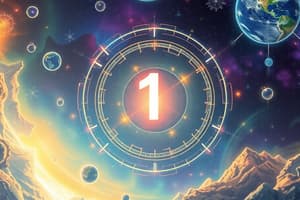Podcast
Questions and Answers
What does the atomic number (Z) represent in an element?
What does the atomic number (Z) represent in an element?
- The number of neutrons in the nucleus
- The total number of protons and neutrons
- The number of protons in the nucleus (correct)
- The average mass of an atom
How is the mass number (A) of an element calculated?
How is the mass number (A) of an element calculated?
- Number of electrons minus protons
- Number of protons minus neutrons
- Total number of electrons plus neutrons
- Number of protons plus number of neutrons (correct)
Which of the following pairs are isotopes?
Which of the following pairs are isotopes?
- Carbon-12 and Carbon-14 (correct)
- Sodium and Potassium
- Boron-10 and Boron-11 (correct)
- Oxygen and Hydrogen
If an element has an atomic number of 19 and a mass number of 41, how many neutrons does it have?
If an element has an atomic number of 19 and a mass number of 41, how many neutrons does it have?
The notation for an isotope includes which of the following?
The notation for an isotope includes which of the following?
How many electrons does a neutral atom of chlorine with a mass number of 35 and atomic number of 17 have?
How many electrons does a neutral atom of chlorine with a mass number of 35 and atomic number of 17 have?
What is the relationship between the atomic number and the number of neutrons in an element?
What is the relationship between the atomic number and the number of neutrons in an element?
Which of the following is NOT a group on the periodic table?
Which of the following is NOT a group on the periodic table?
What are the horizontal rows in the Periodic Table called?
What are the horizontal rows in the Periodic Table called?
Which of the following groups contains the halogens?
Which of the following groups contains the halogens?
Which type of element is typically a poor conductor of heat and electricity?
Which type of element is typically a poor conductor of heat and electricity?
What characterizes metalloids in the Periodic Table?
What characterizes metalloids in the Periodic Table?
What is the average atomic mass of an element generally based on?
What is the average atomic mass of an element generally based on?
Why is the atomic mass of carbon listed as 12.01 amu instead of 12.00 amu?
Why is the atomic mass of carbon listed as 12.01 amu instead of 12.00 amu?
Which group of elements is referred to as alkali metals?
Which group of elements is referred to as alkali metals?
What are noble gases known for?
What are noble gases known for?
Flashcards are hidden until you start studying
Study Notes
Atomic Number, Mass Number, and Isotopes
- The atomic number (Z) is the number of protons in an atom's nucleus, defining its element.
- The mass number (A) is the total number of protons and neutrons in an atom's nucleus.
- The mass number can be calculated using the formula: mass number (A) = number of protons (Z) + number of neutrons
- Isotopes are atoms of the same element with the same atomic number but different mass numbers.
- Isotopes differ due to the varying number of neutrons in their nuclei.
The Periodic Table
- The periodic table organizes elements based on their atomic number, with horizontal rows called periods and vertical columns called groups or families.
- Elements in the same group tend to have similar chemical and physical properties.
- Elements are categorized as metals, nonmetals, or metalloids based on their properties.
- Metals are typically good conductors of heat and electricity.
- Nonmetals are generally poor conductors of heat and electricity.
- Metalloids have properties that are intermediate between metals and nonmetals.
The Atomic Mass Scale and Average Atomic Mass
- The atomic mass unit (amu) is a standard unit used to measure the mass of atoms and molecules.
- The average atomic mass of an element is the weighted average of the atomic masses of its naturally occurring isotopes.
- The average atomic mass reflects the relative abundances of the different isotopes of an element.
- For example, the average atomic mass of carbon is 12.01 amu, reflecting the presence of different carbon isotopes.
Studying That Suits You
Use AI to generate personalized quizzes and flashcards to suit your learning preferences.



